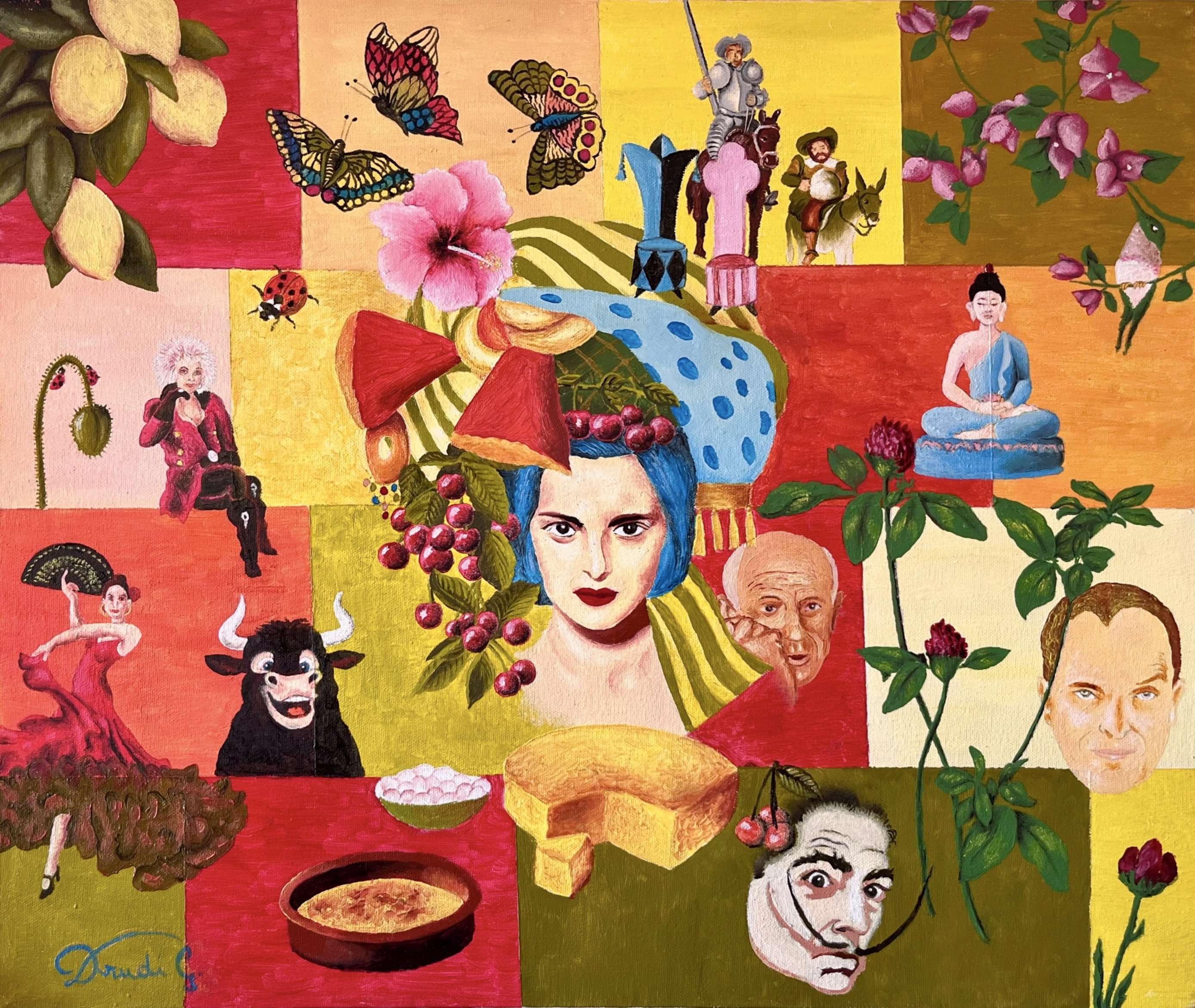SPAIN
2023, 50x60cm, Bright oil on canvas

Scene that portrays a tribute to major Spanish exponents, a woman dancing flamenco, Pablo Picasso, Salvador Dalí, Miguel Bosé, a bull, Catalan cream, Don Quixote and Sancho Panza, Ivana Spagna who “unites” the Italian origins of the painter with his move to Spain, and finally at the center a woman with a hat covered with tropical fruits and flowers.
The work presents itself as a joyful pictorial composition, organized in a grid of colored squares in warm and vivid tones - mainly reds, yellows, and oranges. At the center of the work stands out a female figure with an elaborate hat decorated with tropical fruits, flowers, and mushrooms. The composition includes numerous elements of Spanish culture arranged in the various squares.
Painting technique:
The work is created on canvas, using bright oil colors. The technique recalls the style of artistic patchwork, where each square is painted with vivid and contrasting colors that create a visual effect of great impact. The contours are well defined, with a detailed but stylized figurative rendering. The artist has worked with a predominant palette of primary and complementary colors, creating a vivid and festive effect. The treatment of light is flat, typical of a decorative style that privileges chromatic impact over chiaroscuro. A signature can be noted in the lower left corner, highlighting the identity of the author of the work.
Symbolic elements or hidden meanings:
The work represents a tribute to Spanish cultural influences, but also a bridge between different cultures. The central figure with the fruit hat recalls Carmen Miranda, a symbol of exoticism and meeting between different cultures, serving as a metaphor for the cultural dialogue between Italy and Spain mentioned in the description. The portraits of Dalí and Picasso pay homage to two of the greatest Spanish artists of the 20th century, while the bull and the flamenco dancer represent deep-rooted folkloric traditions. The presence of gastronomic elements such as Catalan cream underlines the importance of food as cultural expression. The figure of Buddha introduces an intercultural element that suggests a global and inclusive vision. The reference to Don Quixote evokes classic Spanish literature, while the presence of Ivana Spagna creates a play on words with the title of the work and symbolizes the artist’s personal connection with the two countries.
Conclusion:
“Spain” presents itself as a work rich in cultural references that celebrates Spanish identity through its most representative symbols, while creating a bridge with the artist’s Italian origins. The mosaic composition allows to visually tell multiple aspects of Spanish culture, from its artistic exponents to popular traditions, from gastronomy to literature. The result is a vivid and festive work that immediately communicates a sense of cultural richness. The colorful technique and the almost naïve approach in the representation give the work a joyful and accessible character, inviting the observer to discover the numerous details and references hidden in the various squares that compose this fascinating tribute to Spain.

Scene that portrays a tribute to major Spanish exponents, a woman dancing flamenco, Pablo Picasso, Salvador Dalí, Miguel Bosé, a bull, Catalan cream, Don Quixote and Sancho Panza, Ivana Spagna who “unites” the Italian origins of the painter with his move to Spain, and finally at the center a woman with a hat covered with tropical fruits and flowers.
The work presents itself as a joyful pictorial composition, organized in a grid of colored squares in warm and vivid tones - mainly reds, yellows, and oranges. At the center of the work stands out a female figure with an elaborate hat decorated with tropical fruits, flowers, and mushrooms. The composition includes numerous elements of Spanish culture arranged in the various squares.
Painting technique:
The work is created on canvas, using bright oil colors. The technique recalls the style of artistic patchwork, where each square is painted with vivid and contrasting colors that create a visual effect of great impact. The contours are well defined, with a detailed but stylized figurative rendering. The artist has worked with a predominant palette of primary and complementary colors, creating a vivid and festive effect. The treatment of light is flat, typical of a decorative style that privileges chromatic impact over chiaroscuro. A signature can be noted in the lower left corner, highlighting the identity of the author of the work.
Symbolic elements or hidden meanings:
The work represents a tribute to Spanish cultural influences, but also a bridge between different cultures. The central figure with the fruit hat recalls Carmen Miranda, a symbol of exoticism and meeting between different cultures, serving as a metaphor for the cultural dialogue between Italy and Spain mentioned in the description. The portraits of Dalí and Picasso pay homage to two of the greatest Spanish artists of the 20th century, while the bull and the flamenco dancer represent deep-rooted folkloric traditions. The presence of gastronomic elements such as Catalan cream underlines the importance of food as cultural expression. The figure of Buddha introduces an intercultural element that suggests a global and inclusive vision. The reference to Don Quixote evokes classic Spanish literature, while the presence of Ivana Spagna creates a play on words with the title of the work and symbolizes the artist’s personal connection with the two countries.
Conclusion:
“Spain” presents itself as a work rich in cultural references that celebrates Spanish identity through its most representative symbols, while creating a bridge with the artist’s Italian origins. The mosaic composition allows to visually tell multiple aspects of Spanish culture, from its artistic exponents to popular traditions, from gastronomy to literature. The result is a vivid and festive work that immediately communicates a sense of cultural richness. The colorful technique and the almost naïve approach in the representation give the work a joyful and accessible character, inviting the observer to discover the numerous details and references hidden in the various squares that compose this fascinating tribute to Spain.